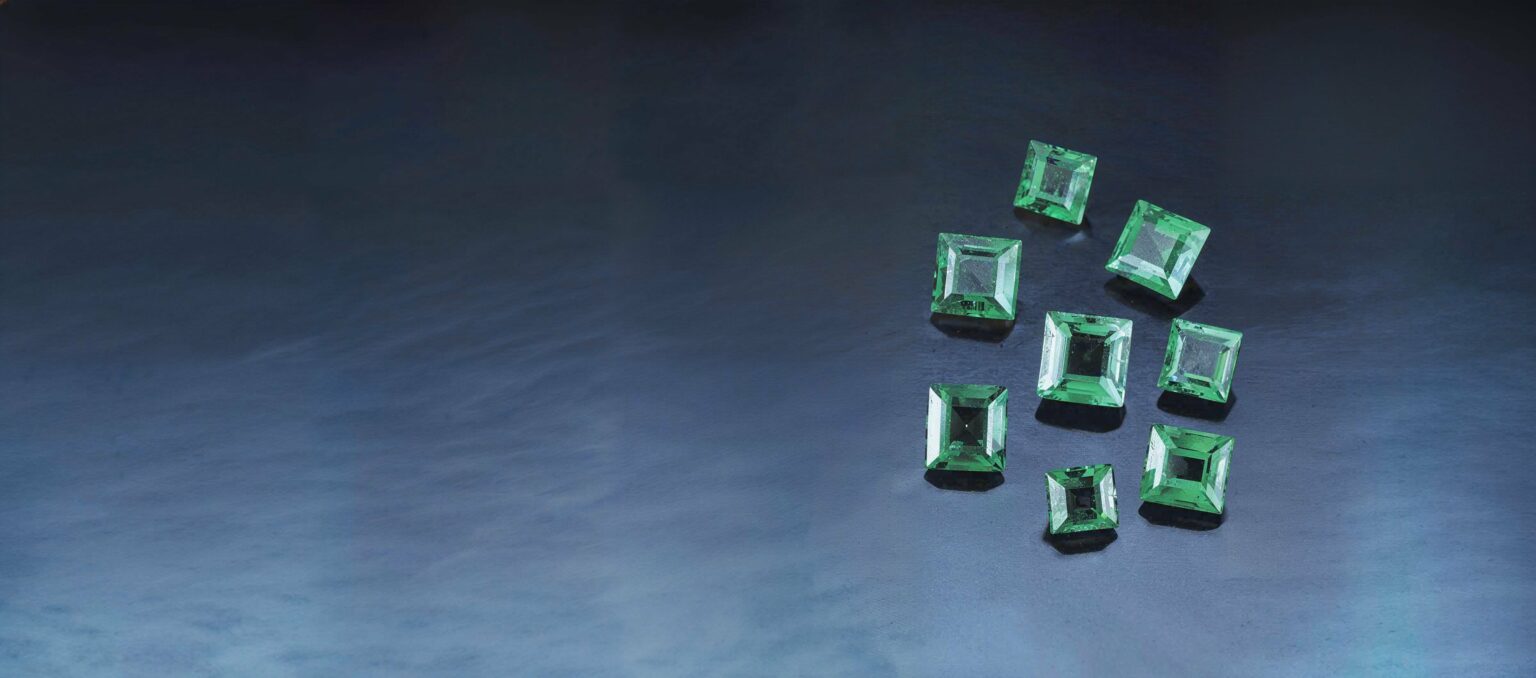You’ve heard of Plato, the ancient Greek philosopher who taught that everything in the material world is a more or less imperfect copy of its original, ideal form stowed in eternity? Well, let’s suppose he had sold gems on the side. And let’s suppose he’d received a parcel of top-grade emeralds from the Sandawana mine in what is now Zimbabwe (formerly Rhodesia). How close to the ideal, or archetype, would he have thought these stones?
As close to perfection as emerald gets. That’s why Sandawana emerald, discovered in 1956, quickly reached cult status among dealers and has never waned since for fervent admirers.
Those fortunate enough to have sold these southern African emeralds talk about the finest of them with the rapture and reverence reserved for Kashmir sapphires and Burmese rubies. Just listen to emerald specialist Kevin Kassdin, of Bliss & Kassdin Inc., New York: “The finest emerald I’ve ever seen was a 3-carat Sandawana stone shown me in 1980. Its owner, an Indian dealer, wanted a mind-boggling $60,000 per carat. But eventually he got it.”
Granted, 3-carat stones of that caliber from Sandawana are extremely rare—so rare that it is possible many precious stone dealers have spent their entire careers without seeing a large Sandawana stone like it. On the other hand, seeing stones of comparable beauty in melee and sub-carat sizes was a common occurrence during the two decades when this mine flourished. In fact, Sandawana challenged every aesthetic notion about emerald by proving this beryl could boast a depth and richness of color thought possible only in larger sizes (the result of ultra-high concentrations of the greening agent, chromium). What’s more, stones were remarkably clean, crystalline, and fracture-free—the latter virtue so pronounced that oiling a common touch-up process for emerald, was usually unnecessary.
Nor wonder dealers who sold Sandawana stones during their heyday in the 1960s and 1970s long for their return to these shores. “Sandawana melee is the world’s finest,” exclaims Ray Zajicek, Equatorian Imports Inc., Dallas. Enthusiasts like Zajicek may soon have a second fling with these green glories.
In June 1992, emerald trader Tom Lee, Gemstone Resources PLC, London, and Grand Rapids, Mich., bought the Sandawana mine from its owner, Rio Tinto Zimbabwe, and launched the most ambitious marketing campaign ever on behalf of this emerald. “America is ready for another love affair with Sandawana emerald,” he says.
A Dream for One
The first love affair began shortly after Rio Tinto bought the Sandawana mine in 1958. Seven years later, when it decided to switch to a distribution system based on the De Beers single-channel market model for diamonds, it put sales of rough and cut stones in the hands of French gem dealer Jean Rosenthal. He assigned five dealers, himself included, exclusive franchises in France, Germany, Switzerland and the Americas.
For New York dealer Maurice Shire, who oversaw sales in the U.S. from 1965 until 1983, it was a business arrangement as close to ideal as the product itself. Once every 10 to 12 weeks for over 18 years, Shire flew to Paris where he bought the equivalent of a “sight” in Sandawana goods, the most desirable small emeralds in history. While these offerings cost him, on average, $300,000 to $400,000, “they were,” he says, “worth every penny.”
At least for the first 10 years. Then the assortments gradually tapered off in terms of quality and quantity—with a corresponding drop in price. In 1982, the government of Zimbabwe stepped in and insisted buyers come to Africa. By then, prices for Sandawana melee were more than twice ($1,600 versus $700 per carat) those of decent but hardly legendary stones from Zambia being dumped on the market. Unable to compete with the onslaught of these African goods, Shire gave up the U.S. concession for Sandawana emerald in 1983.
To this day, that market slot remains vacant. But it may finally be filled in 1993 because the Sandawana mine’s new owners plan to restore production to former heights. What’s more, since 1986, a second mine at Machingwe has been producing goods said to rival those of Sandawana at its peak in the 1960s. All in all, Zimbabwe seems poised for a U.S. market comeback.
Small Talk
As if solely an answer to a pressing need for majestic emerald melee, flights, quarters, plus a smattering of thirds and halves, 90% of Sandawana’s production
is of small stones between 2mm and 4mm. The remaining 10% are stones above 1/2 carat. Of the small sizes, an astoundingly high number—Shire puts it at 80%—are of at least commercial quality. “Only 15% are rejection,” he says, “while 5% are top grade.”
Amazingly, even run-of-the-mill stones have a warm, balanced green. But superb color is not this emerald’s only virtue. Because Sandawana stones are exceptionally well-crystallized, they are, Shire says, easier to set and polish. Looking at them in bracelets, both solo and combined with diamonds, one is struck by their resonant color and lustrous appearance. No wonder the Japanese, probably the world’s most ardent devotees of fine emerald, took to these stones immediately after they hit the market.
Will future Sandawana production light as bright a torch among dealers? Keep your fingers crossed. While dealers like Shire believe the mine is largely played out, the shortage of fine material in recent years may have had far more to do with political than geologic. Citizens of Zimbabwe are prevented from accumulating large amounts of foreign currency, as well as transferring significant sums of money out of the country.
As a result, gem smuggling has long run rampant.
But the government of Zimbabwe has been extremely cordial to foreign mining interests—so cordial that greenhorns like Tom Lee are willing to put up with some emerald poaching. Certainly, the smuggling problem isn’t great enough to deter him from trying to bring the Sandawana mine back to the rapturous recovery rates of the 1960s that earned it the nickname of “the Bank of England.”
For the present, activity will be focused at the Zeus mine, Sandawana’s primary mining site since 1958. However, Lee plans to devote increasing amounts of time and energy to exploration of new sites. “There are 27 miles of the claim that haven’t been touched yet,” the mine’s new owner says. “That’s why I think Sandawana has far more of a future than a past.”
Please note: this profile was originally published in 1992 in Modern Jeweler’s ‘Gem Profiles/2: The Second 60’, written by David Federman with photographs by Tino Hammid.
The collection of Sandawana emeralds shown in the header image was courtesy of Maurice Shire Inc., New York.






